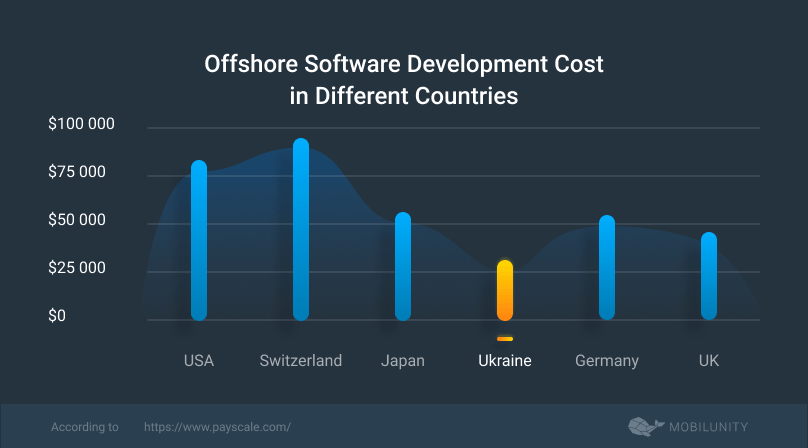OSD (Offshore Software Development)
- A Brief History of the Term and the OSD Meaning
- What Offshore Software Development Models Are There?
- The Size of the OSD Industry in the World
- Benefits of the Offshore Software Development
- Challenges of the Offshore Software Development
- Companies That Have Successfully Used Offshore Software Development Services
- How Much Does Offshore Software Development Cost Worldwide
- References
Offshore Software Development (OSD) is an outsourcing approach [1] allowing businesses to get access to software development services by hiring a remote team from another country. Businesses typically follow the OSD approach to get access to top talent in other countries as it is a cost-effective and working business strategy to get talented specialists across the world.
A Brief History of the Term and the OSD Meaning
Although the term is widely used today, many companies still do not exactly know what is OSD and where the term comes from. Three researchers from Sao Paulo confirmed that the term “offshore outsourcing” was first used by the economist Ronald Coase. Coase published a paper [2] about this form of organizing business overseas in 1937. However, Rose India Technologies, an information technology company in India, claimed in an article that the origin of the term actually traces back in time to the first industrial revolution.
The origin of the term may not be confirmed, but economists and authors mostly agree that the term only became common around the mid-20th century. Back then, it was mostly applicable in the manufacturing industry [3] that started using offshoring. Businesses realized that they could save a lot of money by outsourcing certain manufacturing processes to companies in other countries. Since then, offshore outsourcing quickly gained popularity across many different industries, including information technology. Increasingly more businesses are opting to outsource specifically software development. This involves businesses hiring talented software developers from other countries to work on development projects, such as web and mobile applications. Offshore software development allows businesses to get access to top international talent and to save costs. As a result, many offshore software companies have been established, specializing exclusively in this type of service.
What Offshore Software Development Models Are There?
OSD is a common approach used by many businesses, from large enterprises, SMEs, and startups. To ensure an OSD partnership is relevant and that offshore software development best practices are always in place, there are several OSD business models to fit a specific need. The basic form of these models can be categorized into three groups: low-level, high-level, and complete technical.
OSD Levels Model
- Low-level outsourcing. The low-level involves outsourcing service providers to take on a client business’s development and QA processes, while product management is handled by the client. A newcomer offshore software development company will typically offer low-level outsourcing.
- High-level outsourcing. With high-level outsourcing, additional responsibilities are given to the outsourced team, which may include product management. Compared to the low-level model, this model may be more costly to a business.
- Complete technical outsourcing. Complete technical outsourcing involves businesses outsourcing all technical tasks to the outsourced team, including the design and implementation phases.
OSD Business Model
From an economic perspective, different business models also exist. These include:
- Fixed cost. The fixed cost model exists to eliminate any extra or hidden costs. This model allows businesses to use a one-off established cost for outsourced services.
- Dedicated resource model. The dedicated model involves an outsourced team that works exclusively on your project. The team typically works from start to end of project execution and delivers the end product according to a certain deadline.
- Time and material or hourly model. Often, the scope of work a project requires cannot be determined. With the hourly model, the client is charged for the precise amount of time or efforts spent on the project.
OSD Service Model
Service models are applied when the company delegates a certain amount of work, usually a part of a big project.
- Staff augmentation. Based on this model, a client extends their in-house teams with offshore developers. By hiring remote workers, an employer saves time for searching the employees in a local market. Also, it is more possible to focus on core in-house operations while the side projects are executed by remote teams.
- Offshore development center. For long-term projects, this model is ideal. It allows outsourcing providers to put together a dedicated team to work exclusively on one big project.
- Project-based. For projects with defined timeframes and low to medium complexity, this model is most fitting. It allows businesses to hire a team one-off only for the period outlined by the timeframe.
Offshore software development trends may come and go, but these models are generally a permanent guide on how to approach offshore software development.
The Size of the OSD Industry in the World
The OSD approach has truly become a global trend and with a bigger focus on lowering costs and smaller in-house teams, OSD is only growing. According to Statista [4], the global market size of outsourced services is currently $92,5 billion. These statistics also show how OSD has grown rapidly between 2000 and 2019. It is predicted that the next ten years will see an even sharper rise.
Benefits of the Offshore Software Development
OSD services became popular because businesses realized the many benefits it offered. These benefits include:
- Less costs involved. Many OSD companies charge either a one-off fee or a set, ongoing rate with no hidden costs or extra HR and employment insurance fees. This allows businesses to save capital in the long run.
- Access to top talent. Businesses can hire top candidates with expert skills from around the world.
- Increased flexibility. Teams can be hired as and when needed according to a business’s project needs.
- Easy scalability. Teams can be scaled up or down at ease according to project requirements.
- Improved productivity. Outsourced teams are often completely dedicated to one project.
These benefits allow businesses to prosper when it comes to their offshore web and offshore mobile software development. In turn, this can lead to increased revenue and ultimately, business success.
Challenges of the Offshore Software Development
As with any type of hiring approach, there are some challenges involved in investing in offshore software development services. These difficulties should be carefully considered before investing in these services. The challenges include:
- Language and cultural barriers. Some countries have completely different languages and cultures, which may lead to miscommunication.
- Difficult logistics. It may be difficult to manage teams remotely if the correct processes are not put in place.
- Poor team cohesion. Due to individuals working remotely, they may often feel left out and poorly integrate with in-house teams when needed.
Luckily, most of these trials can be overcome with the right processes and systems in place. It all starts with having excellent communication methods in place. This will ensure that no information is lost during the partnership.
Companies That Have Successfully Used Offshore Software Development Services
Due to the many benefits OSD offers, several big international companies have invested in this type of service. A few examples of such companies include:
WhatsApp
When WhatsApp [5] was still in its development phase, the owners of the popular mobile application were looking for ways to lower costs. Therefore, they hired an iOS developer from Eastern Europe. The partnership was a highly successful one.
Slack
Slack [6] is a popular cloud-based service specifically for communication. It owes its success to an OSD team that created Slack’s logo, app and web design.
Alibaba
Alibaba [7] is one of the largest online marketplaces in the world. The company was established by Jack Ma Yun in 1999. During its development, the company lacked skilled and experienced software developers and they decided to outsource. Since then this big e-commerce has grown exponentially.
GitHub
It is almost impossible to think that GitHub [8], a Git repository hosting service, once made use of OSD services. This successful company that now has 27 million active users was looking for top-level experts when they first started. They also had limited funds and decided that investing in OSD services was the best option. It proved to be a highly profitable decision.
How Much Does Offshore Software Development Cost Worldwide
Offshore software development costs differ greatly from country to country. There are many reasons for this, including the cost of living in certain countries. According to Payscale [9], the average annual offshore software development rates by country are:
| USA | UK | Germany | Switzerland | Japan | Ukraine | |
| $ annual | $84,372 | $45,955 | $53,757 | $95,605 | $55,591 | $30,000 |
From the table above, it is evident that Switzerland has some of the highest rates for offshoring in West Europe, while Ukraine has the lowest average hourly rates in East Europe. This may be due to the difference in the cost of living, Ukraine is Europe’s most affordable country [10]. Today, Ukraine is also expanding its offshore software development center to offer an even better outsourcing solution, with top talent at affordable rates for businesses around the world.
See Also
References
-
- https://mobilunity.com/blog/offshore-software-development-services
- https://connectamericas.com/content/how-did-concept-outsourcing-begin
- https://www.dailykos.com/stories/2013/6/13/1216104/-U-S-Manufacturing-Off-shoring-1979-to-Re-shoring-2013
- https://www.statista.com/topics/1900/it-outsourcing
- https://populartimelines.com/timeline/WhatsApp
- https://www.bloomberg.com/quicktake/alibaba
- https://www.cnbc.com/2018/06/04/chris-wanstrath-co-founded-github-which-microsoft-bought-for-billions.html
- https://www.payscale.com

















